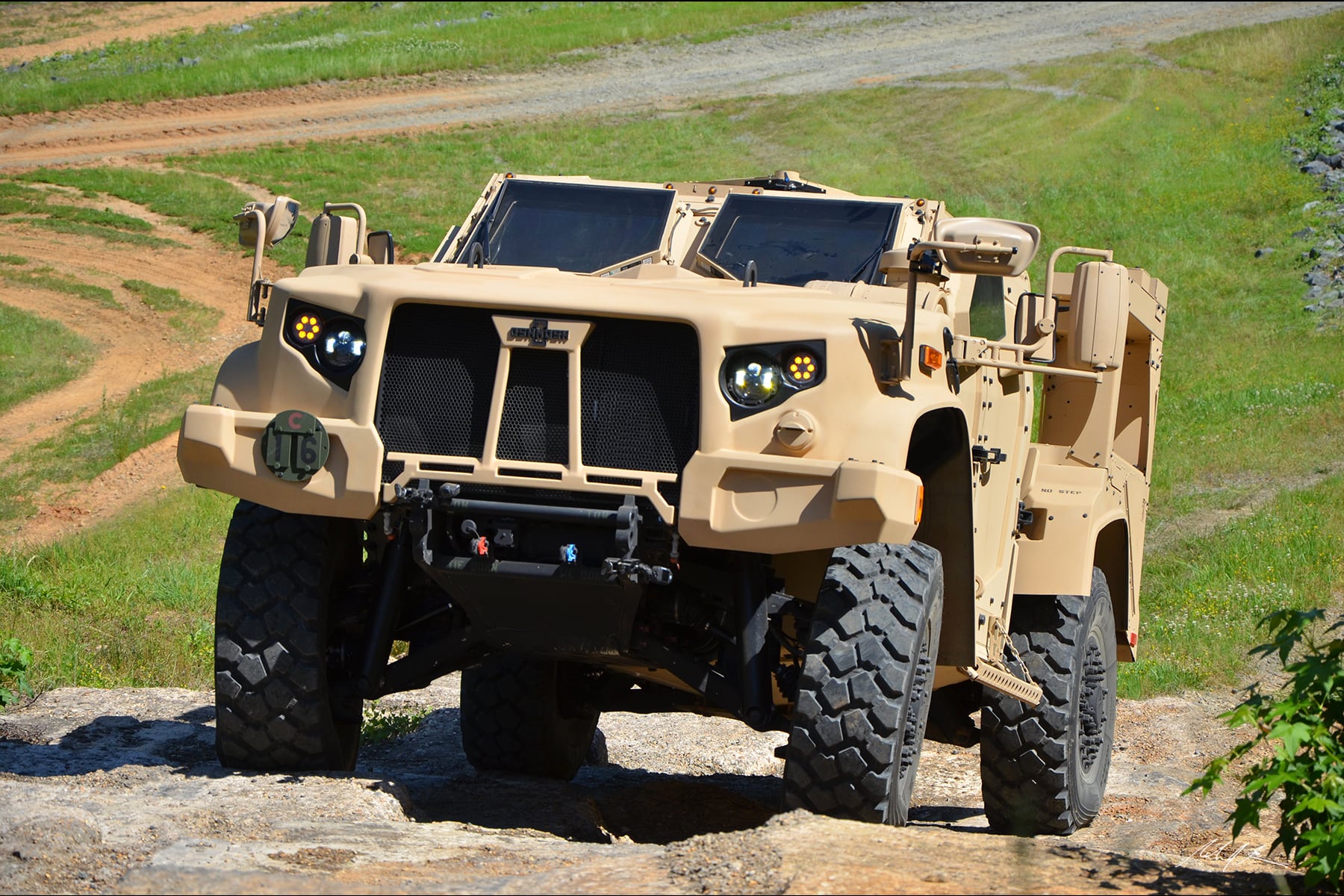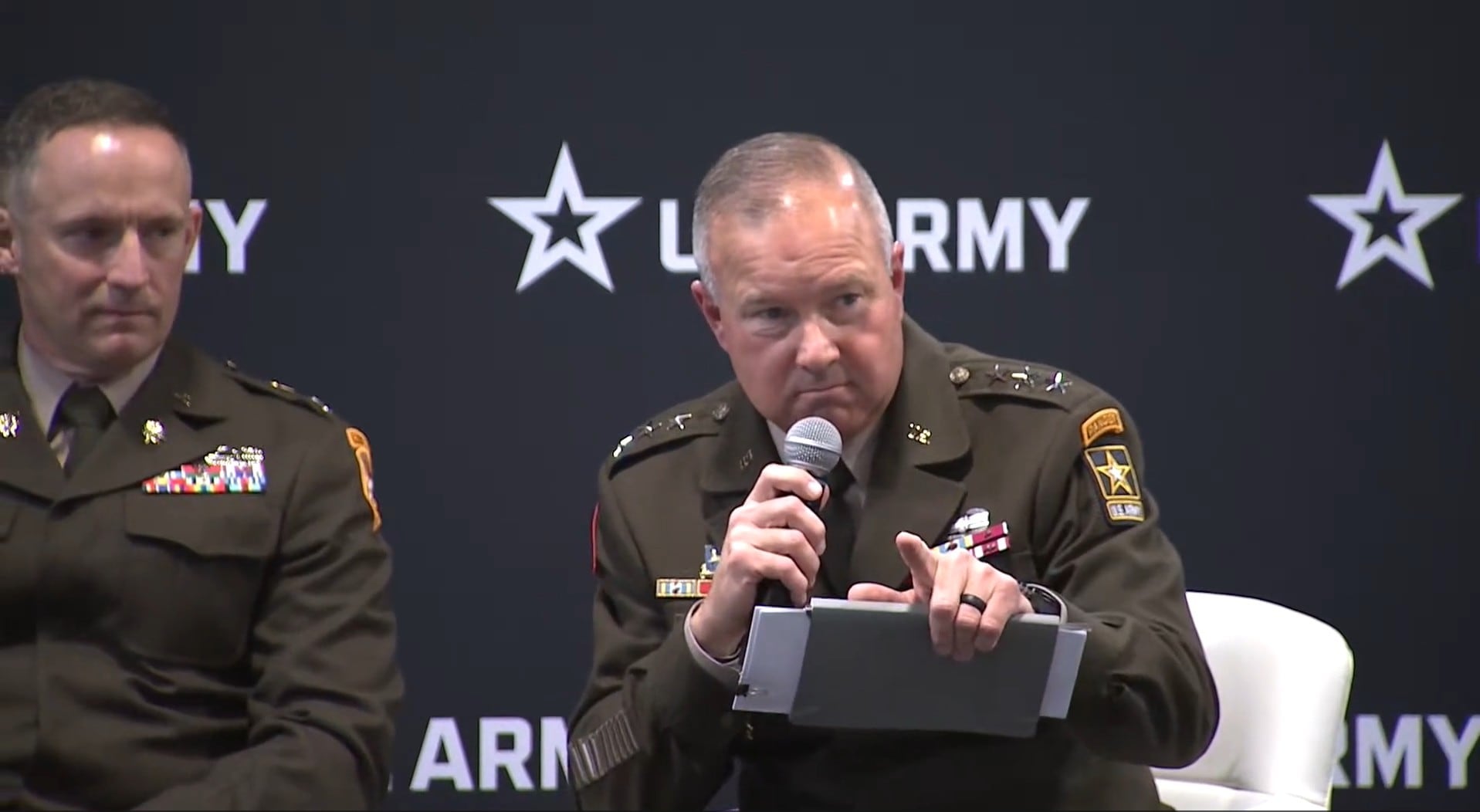Freshly minted Marines at the School of Infantry West at Camp Pendleton, California, are some of the first jarheads to see the newest ground combat vehicle in action as fielding of the Joint Light Tactical Vehicle begins this week.
The 55 JLTVs will first arrive at support units such as SOI West in California, SOI East in North Carolina and the Motor Transport Maintenance Instruction Company between now and Memorial Day, officials said.
The first operational unit to get the new truck will be 3rd Battalion, 8th Marines, at Camp Lejeune, North Carolina, in July, said Andy Rodgers, Marine program manager for light tactical vehicles.
The vehicle is set to replace many of the aging Humvee fleet. It is a faster and more ruggedized vehicle, built to better protect Marines and soldiers as priorities shift to a more competitive, near-peer battlefield.
Its protection, extreme off-road mobility, modularity and network capabilities far exceed the Humvee and provide a suite of capabilities in a smaller, faster package than the Mine Resistant Ambush Protected, or MRAP, vehicles developed to counter roadside bombs that have shredded many Humvees.
RELATED

Rodgers spoke with reporters about the fielding and addressed deficiencies that were noted in a recent report by the Office of the Director, Operational Test and Evaluation.
That report noted all versions of the vehicle at the time were “not operationally suitable because of deficiencies in reliability, maintainability, training, manuals, crew situational awareness, and safety,” according to the report.
In separate interviews both Rodgers and Oshkosh Defense President John Bryant, the company that manufactures the JLTV, noted that the report’s findings were from May 2018 and work done to fix problems found during testing were not included in the final report.
“It’s kind of like reading a report from September now that’s an assessment of whether the New England Patriots are going to do well in the playoffs,” Bryant said. “It turns out they did pretty well.”
Nearly all items mentioned in the report have been addressed and applied to the current vehicles headed to the fleet. Some minor adjustments are being evaluated by the services but will require slight modifications to the fleet at a later date.
The vehicle comes in two- and four-seat versions with four basic configurations — general purpose, utility vehicle, heavy guns carrier and close combat weapons carrier.
The most striking problem was that the close combat version “provides less capability to engage threats with the (Tube-launched, Optically tracked, Wire-guided) missiles” over the Humvee.
“The missile reload process is slow and difficult for crews,” according to the report and the close combat version has “less storage space than other JLTV variants and accessing mission-essential equipment from the cargo area is a challenge.”
For those reasons, evaluators at the time deemed the close combat JLTV, “not operationally effective.”
The term “operationally effective” is used to determine if the system can accomplish the mission it is intended to in as realistic an environment that can be tested.
“Operationally suitable” means whether the system can be placed in the field, remain reliable and be sustained within the unit and support available.
Rodgers told reporters that working with the TOW system on the JLTV will require improved tactics, techniques and procedures by Marines getting familiar with the vehicle.
Bryant said that the company made changes to the storage and accessibility of missiles and added shielding to cables that allowed for better accessibility and a greater field of fire.
Those changes have been incorporated already on the vehicles being fielded, he said.
The report also found problems for users exiting the vehicle, noting, “numerous reliability failures of doors not opening impeded the ability of the soldiers and marines to safely ingress and egress the JLTV.”
Rodgers said there had been minor changes made to the doors. The armored door system is slightly more complex than the Humvee and takes some experience to learn.
Crews also had, “poor visibility due to blind spots around the vehicle,” according to the report.
Testers are looking to add an additional hatch to the versions that do not have turrets so that the vehicle will have another egress, or exit, option in case of a vehicle rollover, Rodgers said.
Bryant said that the hatch will be added to the variants that don’t already have turrets, which double as escape hatches.
As far as visibility issues, Rodgers said Army officials began looking at ways to modify elements of the vehicle back in December to resolve those problems.
“A decision was made back in December for the army to pursue expanding the visibility of the vehicle, improving size of rear windows, putting a front camera on the JLTV,” Rodgers said.
Bryant added that once there is a decision on those items they can be included in future JLTV production and modified on those already with Marines and soldiers, a common practice when improvements are made to any piece of gear, from radios to vehicles to rifles.
Report authors cited a lack of maintenance capabilities and overreliance on contractor support to provide maintenance.
“Units cannot maintain the JLTV without support from the contractor field service representatives due to vehicle complexity, ineffective training, poor manuals, and challenges with troubleshooting the vehicle,” according to the report.
The reliability problems included engine wiring, flat and damaged tires and brake system faults.
Bryant pointed out that in testing one unit had a number of flat tires while another unit running over the same terrain did not have tire problems.
He added that the vehicle has undergone more than 100,000 miles of testing and the JLTV was assessed as meeting double the reliability requirement set for it.
Rodgers clarified specific to training that during the early stages of developing the JLTV, maintenance training, manuals and related support were deprioritized to save both time and money and since the evaluation last year, training and other maintenance support has been ramped up to meet the force needs.
At the time, Marines were using a 40-hour maintenance training set. But, Rodgers said, an 80-hour course was developed and validated and has been in place for maintenance personnel since October.
A short line in the report noted that JLTVs would need more maintenance due to some of their complexity. Rodgers went a little deeper by explaining that while Humvees can hit operational failures at around the 500 to 600-mile mark, JLTVs lowest mileage estimates in testing to those types of failures was 2,400 miles.
So, while actually working on and fixing the JLTV may be more time intensive and complex, Rodgers said that it will likely work longer with less regular maintenance than the Humvee.
Once operators and maintainers are more familiar with the JLTV, “the reliability of the vehicle will go up, which means there will be less maintenance on the vehicles,” he said.
Compared to the Humvee there is already less maintenance needed on the JLTV, he said.
Another concern arose in testing when existing Humvee trailers didn’t work properly with JLTVs. The Marines have since purchased 30 JLTV-specific designed trailers and will continue with research and development into next year to find a solution, he said.
Once finalized, the Corps expects to buy 318 trailers by 2022, Rodgers said.
The JLTV is bigger than the Humvee, which has consequences for what Marines bring to the fight.

Rodgers said there is about a 10 percent loss, or 90 JLTVs for every 100 Humvees, aboard Maritime Prepositioning Ships, the ships that carry combat inventory to meet up with Marine units in theater.
But the reduction is much less on the Marine Expeditionary Unit, Amphibious Readiness Group configuration for Marines on sea-based rotational deployments.
That is only a 2 percent loss, or 98 JLTVs for every 100 Humvees, Rodgers said.
As far as air transport, the report noted that Marines can conduct air assaults, like with the V-22 Osprey as their taxi, and keep the B-kit armor package on the vehicle.
But soldiers will have to remove the B-kit armor because with that layer the vehicle is too heavy for the CH-47F helicopter.
The Army fielded its first JLTVs in mid-January to the 1st Brigade Combat Team, 3rd Infantry Division, at Fort Stewart, Georgia.
It’s a combined Army and Marine Corps program, with the Army set to eventually field 49,099 vehicles and the Marines adding a total of 9,091. The Air Force has plans to field 80 vehicles, according to the report.
The totals won’t be complete until the 2020s for the Marines and the 2030s for the Army. And that still won’t entirely replace the Humvee, which is the majority light vehicle in an Army fleet of an estimated 117,000, according to Military.com. That means about 40 percent of Army vehicles will eventually be JLTVs.
The Marines’ acquisition will replace an estimated 60 percent of the existing Humvee fleet with JLTVs.
By September, the Corps expects to have between 250 and 300 JLTVs across the force, with each of the four variants at all three Marine Expeditionary Forces, or MEFs.
Rodgers said the current plan is to field 1,000 JLTVs next year.
Todd South has written about crime, courts, government and the military for multiple publications since 2004 and was named a 2014 Pulitzer finalist for a co-written project on witness intimidation. Todd is a Marine veteran of the Iraq War.




